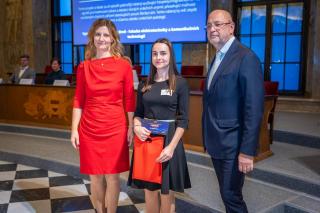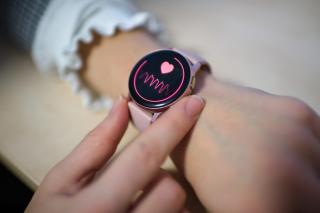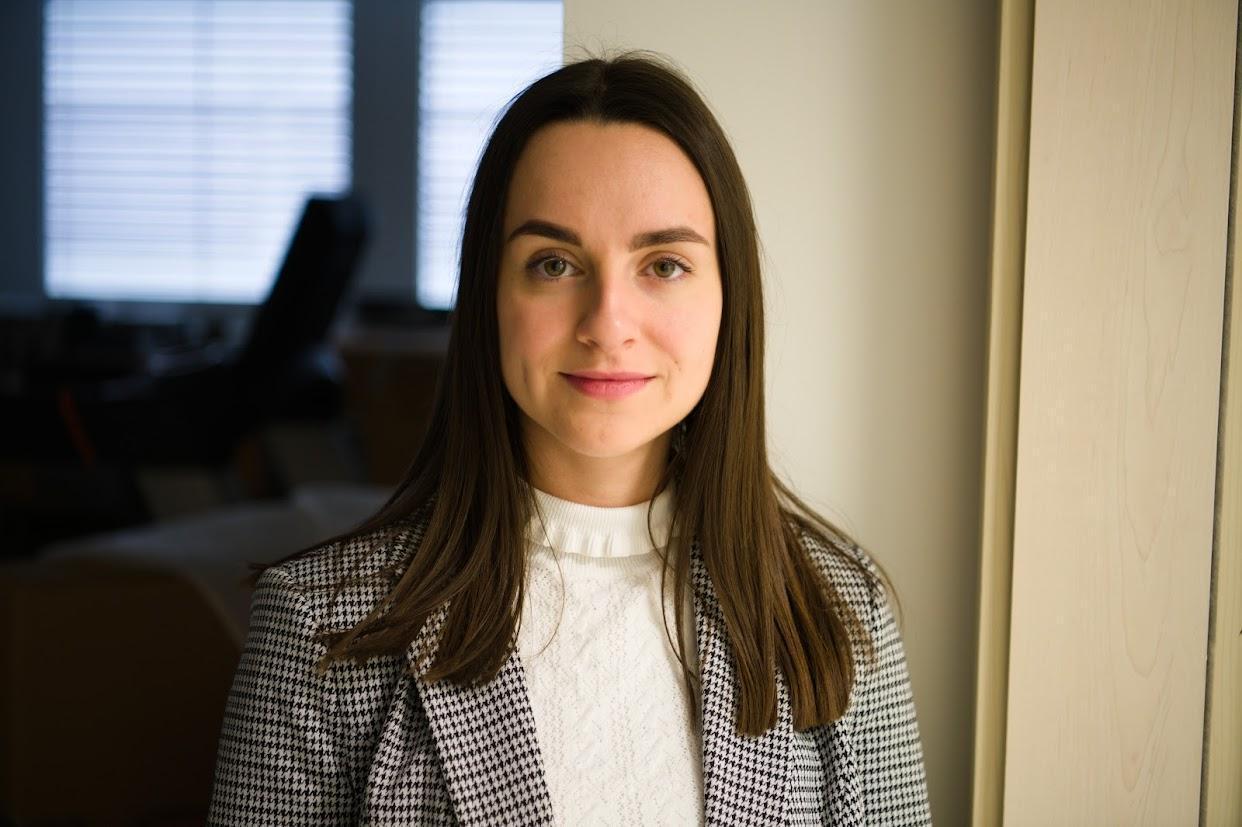
Biomedical PhD student Enikö Vargová succeeded project Brno Ph.D. Talent. | Autor: Oto Janoušek
Biomedical PhD student Enikö Vargová from the Faculty of Electrical Engineering and Communication (FEEC), Brno University of Technology, succeeded in Brno Ph.D. Talent competition and received financial support for her innovative research, which focuses on the development of advanced algorithms for health monitoring using smart devices.
As part of her PhD thesis "Advanced algorithms for health monitoring using smart devices", Enikö uses photoplethysmographic (PPG) signals to detect cardiac arrhythmias. PPG signals reflect changes in the volume of blood flowing in our cardiovascular system, especially in the vascular system below the surface of the skin. The heart pumps blood into the blood vessels, and due to their elasticity, a pulse wave is created that spreads to the fingertips. The pulse wave can be detected at a specific point on the body (e.g. at the fingertip) using light and a sensor. A lot of interesting information about the state of the cardiovascular system can be obtained from PPG, including the detection of cardiac arrhythmias.
However, existing smart devices can only detect one type of cardiac arrhythmia - atrial fibrillation. Enikö Vargová's work focuses on early detection of other cardiac pathologies using artificial intelligence methods. This will enhance the prevention and early detection of these pathologies even in people who do not experience any symptoms or only experience them irregularly and infrequently. Such a person can then be referred to a specialist in time for a more detailed examination and can be prescribed medication in good time, or the problem can be addressed in other ways.
The aim is to diagnose different types of cardiac arrhythmias
"My research opens up new possibilities in the field of health monitoring using smart devices, especially the smartphone, which I see as a powerful tool whose potential is not fully exploited in the field of healthcare and especially prevention. The main goal of the project is to improve the prevention and early diagnosis of cardiac arrhythmias," Enikö explains the contribution of her work.
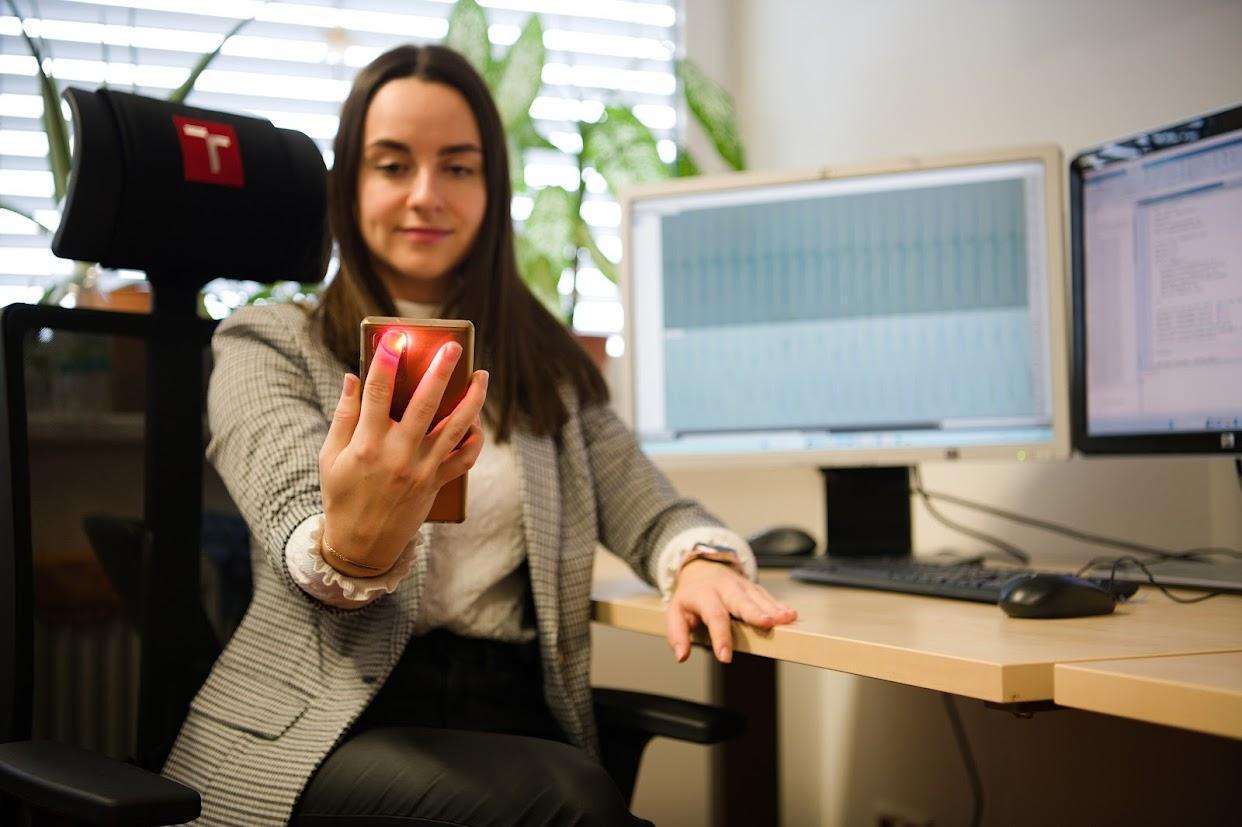
Capturing PPG using a video on your phone | Author: Oto Janoušek
PPG signals have been used in healthcare for a long time and their potential is well known. For example, they can provide information on heart rate, respiratory rate, blood oxygen saturation or blood pressure. "The determination of blood pressure, by the way, is the subject of my colleague Ing. Jan Šíma," adds Enikö.
Extrasystole leads to premature contraction of the heart and thus disrupts the regular rhythm. Some patients do not notice them. Others experience unpleasant symptoms (e.g. palpitations, nausea, chest pressure) and in a small percentage they can lead to left ventricular dysfunction. "I focus on cardiac arrhythmias. So-called smart watches have been popular for some time. These can currently detect only one of the cardiac arrhythmias, namely atrial fibrillation, which is manifested by an irregular heartbeat. My goal is for smart devices to be able to use PPG signals to detect other types of cardiac arrhythmias, such as extrasystoles," says Enikö.
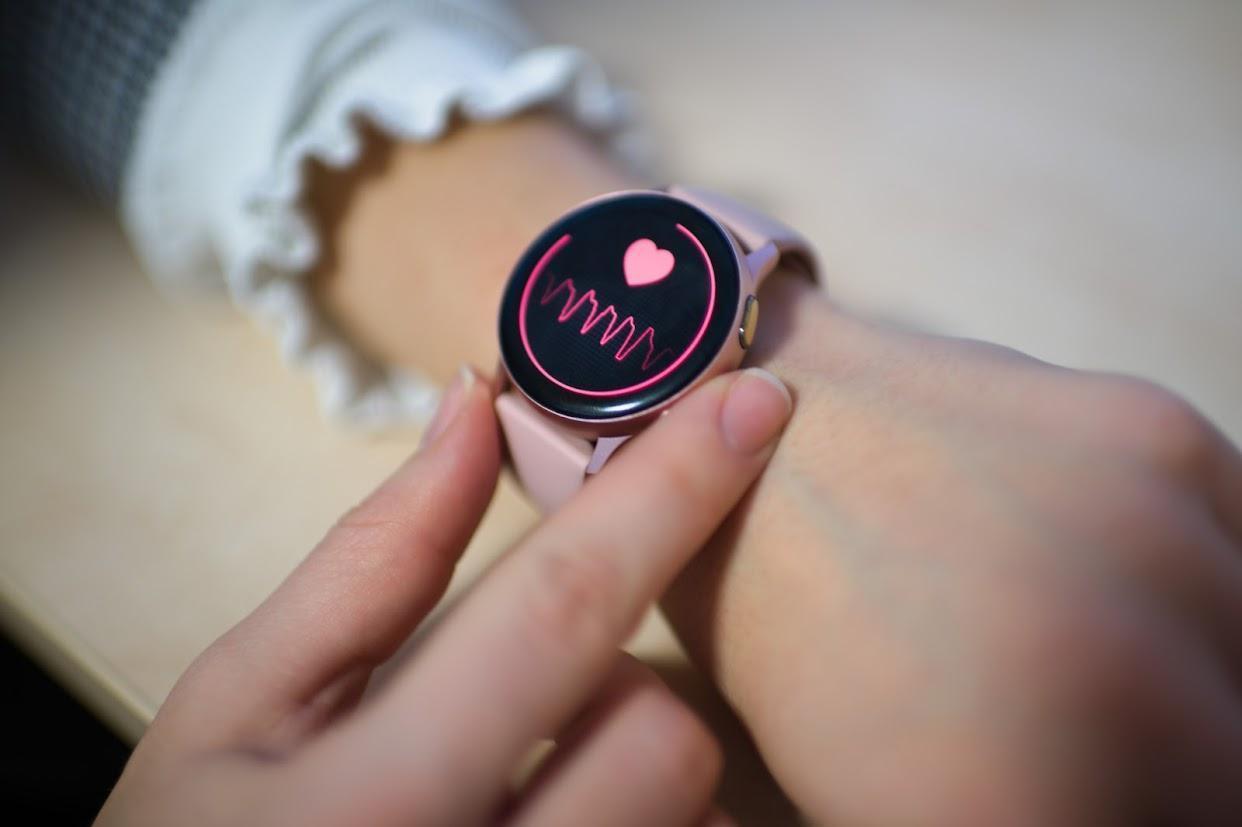
Measuring PPG with a smartwatch | Author: Oto Janoušek
Early detection of cardiac pathologies using PPG signal. Comfortable for the patient
A more familiar method of measuring heart activity to the public, the ECG (electrocardiogram) is a recording of the difference in electrical potential (voltage) at two places on the body. PPG is not intended to be a substitute for it, but due to its wide availability, it can aid early detection of heart disease in a relatively convenient way. If a person now suspects a cardiac arrhythmia, which may be a feeling of weakness, chest tightness or rapid heartbeat, they should contact their GP. After the examination, he or she will write a request for an ECG examination, which must be booked. If it is necessary to monitor the patient's heart function over a long period of time (e.g. because the pathology does not occur continuously), then so-called Holters are used. This device has to be worn for several days, which is not very comfortable and does not guarantee that the pathology will be picked up (it may not even show up during the measurement). Waiting times to rent a Holter recorder are also a problem. "A non-complete but more convenient and affordable alternative is to measure ECGs using a smartwatch. But to do this, you have to create a circuit - actively turn on the measurement and hold the appropriate spot on the watch with your other hand. This way, you don't measure the ECG throughout the day, but only a short, usually half-minute period, which may not detect the arrhythmia," says Enikö.
With the enhanced measurement of PPG signals, it should be possible to detect more cardiac arrhythmias, either in the long term while wearing a smartwatch comfortably or in the short term using only a smartphone app. Then all that would be left to do is to go to the doctor and present the stored data, including the analyses, to the doctor.
Brno Ph.D. Talent
The challenge of detecting cardiac arrhythmias using smart devices requires Enikö to combine technical and medical expertise. Understanding both disciplines has enabled her to study Biomedical Engineering. She gained her technical knowledge at FEEC, and learned medicine at the Faculty of Medicine at MUNI, with which FEEC collaborates to teach this field.
The mentor Andrea Němcová recognized Enikö's scientific abilities already during her bachelor studies:
"Enikö has been pushing the research topic forward significantly since her undergraduate studies, which led to the well-deserved Brno Ph.D. Talent award. " As part of the competition, students have to present their already thought-out topic to an expert committee at the very beginning of their PhD studies. Therefore, anyone who has a clear idea of what they would like to do for the next three years has a chance to succeed in this competition.
"I am very happy that I managed to succeed in such a big competition. Brno Ph.D. Talent award means not only recognition of my work, but also great motivation for my future scientific endeavours," says Enikö.
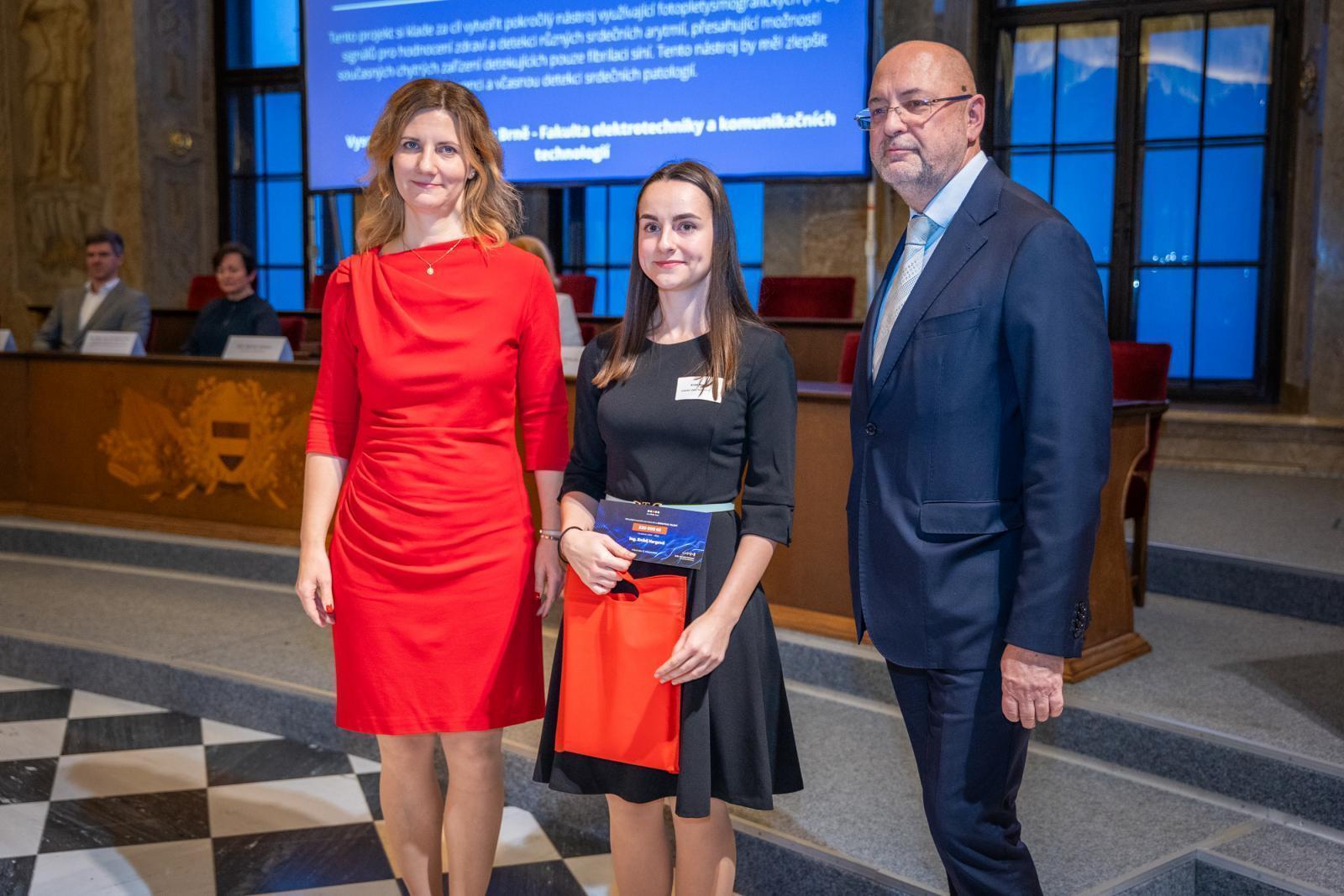
Enikö Vargová receives the Brno Ph.D. Talent award. | Author: Václav Koníček
Open Day decided
Even in high school, Enikö enjoyed biology, chemistry and physics. She was determined to study pharmacy, so she also applied for two pharmacy courses in different cities and was accepted at both universities. But she did not get in. In the end, she decided to go for biomedicine at the Faculty of Science and Technology of the BUT just because of how promising this field is. The combination of technology and medicine has a great future and the field offers a wide range of applications. Moreover, the studies here are divided into bachelor's and master's degrees, which is an advantage you won't find in pharmacy. A visit to the Open Day at FEEC sealed her decision.
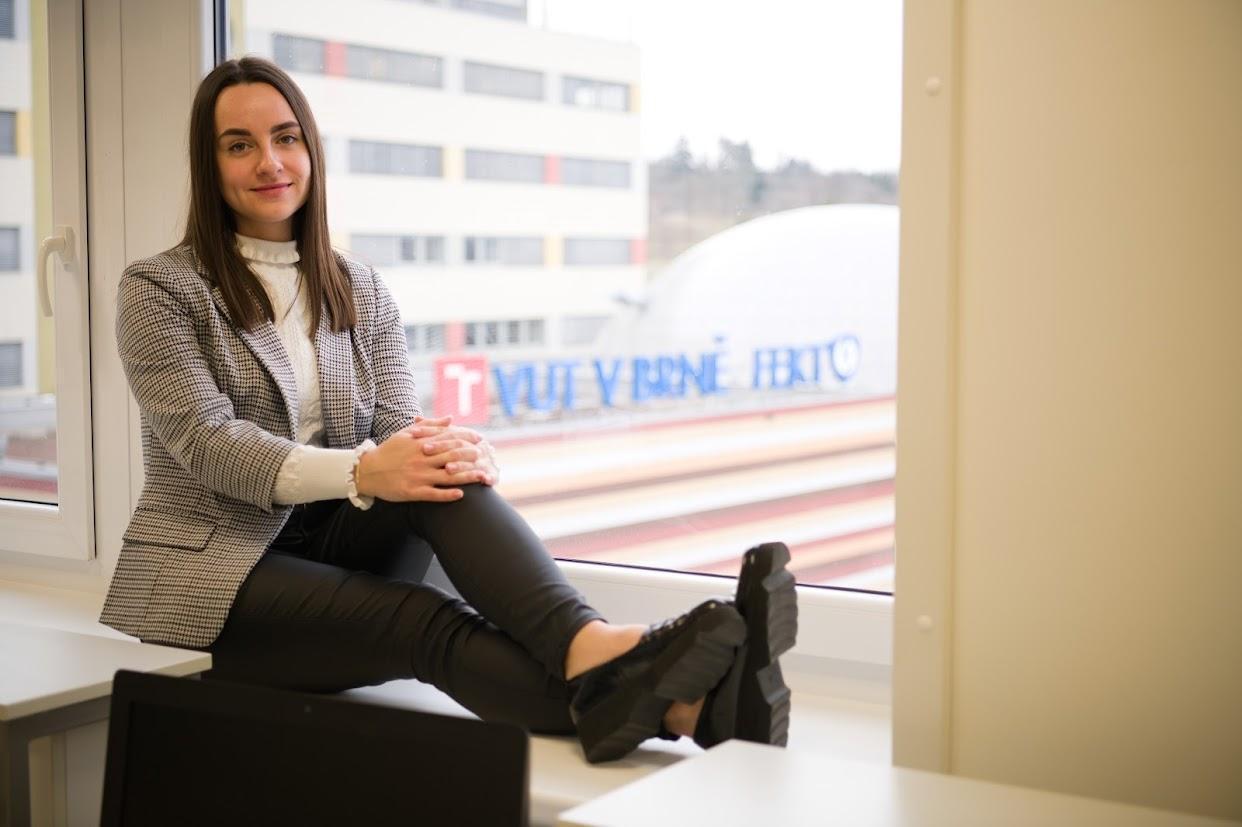
The name Enikö is not typical in the Czech Republic. My father is Hungarian and should be spelled correctly with two commas above the "o" - Enikő. "At the time of my birth, the Czech registry office couldn't cope with it. It was only possible to write dots, which I have left," smiles Enikö. | Author: Oto Janoušek
Authors: Oto Janoušek, Zdeňka Koubová
Enikö Vargová invents an algorithm to detect cardiac arrhythmias using smart devices

Biomedical PhD student Enikö Vargová succeeded project Brno Ph.D. Talent. | Autor: Oto Janoušek
Biomedical PhD student Enikö Vargová from the Faculty of Electrical Engineering and Communication (FEEC), Brno University of Technology, succeeded in Brno Ph.D. Talent competition and received financial support for her innovative research, which focuses on the development of advanced algorithms for health monitoring using smart devices.
As part of her PhD thesis "Advanced algorithms for health monitoring using smart devices", Enikö uses photoplethysmographic (PPG) signals to detect cardiac arrhythmias. PPG signals reflect changes in the volume of blood flowing in our cardiovascular system, especially in the vascular system below the surface of the skin. The heart pumps blood into the blood vessels, and due to their elasticity, a pulse wave is created that spreads to the fingertips. The pulse wave can be detected at a specific point on the body (e.g. at the fingertip) using light and a sensor. A lot of interesting information about the state of the cardiovascular system can be obtained from PPG, including the detection of cardiac arrhythmias.
However, existing smart devices can only detect one type of cardiac arrhythmia - atrial fibrillation. Enikö Vargová's work focuses on early detection of other cardiac pathologies using artificial intelligence methods. This will enhance the prevention and early detection of these pathologies even in people who do not experience any symptoms or only experience them irregularly and infrequently. Such a person can then be referred to a specialist in time for a more detailed examination and can be prescribed medication in good time, or the problem can be addressed in other ways.
The aim is to diagnose different types of cardiac arrhythmias
"My research opens up new possibilities in the field of health monitoring using smart devices, especially the smartphone, which I see as a powerful tool whose potential is not fully exploited in the field of healthcare and especially prevention. The main goal of the project is to improve the prevention and early diagnosis of cardiac arrhythmias," Enikö explains the contribution of her work.

Capturing PPG using a video on your phone | Author: Oto Janoušek
PPG signals have been used in healthcare for a long time and their potential is well known. For example, they can provide information on heart rate, respiratory rate, blood oxygen saturation or blood pressure. "The determination of blood pressure, by the way, is the subject of my colleague Ing. Jan Šíma," adds Enikö.
Extrasystole leads to premature contraction of the heart and thus disrupts the regular rhythm. Some patients do not notice them. Others experience unpleasant symptoms (e.g. palpitations, nausea, chest pressure) and in a small percentage they can lead to left ventricular dysfunction. "I focus on cardiac arrhythmias. So-called smart watches have been popular for some time. These can currently detect only one of the cardiac arrhythmias, namely atrial fibrillation, which is manifested by an irregular heartbeat. My goal is for smart devices to be able to use PPG signals to detect other types of cardiac arrhythmias, such as extrasystoles," says Enikö.

Measuring PPG with a smartwatch | Author: Oto Janoušek
Early detection of cardiac pathologies using PPG signal. Comfortable for the patient
A more familiar method of measuring heart activity to the public, the ECG (electrocardiogram) is a recording of the difference in electrical potential (voltage) at two places on the body. PPG is not intended to be a substitute for it, but due to its wide availability, it can aid early detection of heart disease in a relatively convenient way. If a person now suspects a cardiac arrhythmia, which may be a feeling of weakness, chest tightness or rapid heartbeat, they should contact their GP. After the examination, he or she will write a request for an ECG examination, which must be booked. If it is necessary to monitor the patient's heart function over a long period of time (e.g. because the pathology does not occur continuously), then so-called Holters are used. This device has to be worn for several days, which is not very comfortable and does not guarantee that the pathology will be picked up (it may not even show up during the measurement). Waiting times to rent a Holter recorder are also a problem. "A non-complete but more convenient and affordable alternative is to measure ECGs using a smartwatch. But to do this, you have to create a circuit - actively turn on the measurement and hold the appropriate spot on the watch with your other hand. This way, you don't measure the ECG throughout the day, but only a short, usually half-minute period, which may not detect the arrhythmia," says Enikö.
With the enhanced measurement of PPG signals, it should be possible to detect more cardiac arrhythmias, either in the long term while wearing a smartwatch comfortably or in the short term using only a smartphone app. Then all that would be left to do is to go to the doctor and present the stored data, including the analyses, to the doctor.
Brno Ph.D. Talent
The challenge of detecting cardiac arrhythmias using smart devices requires Enikö to combine technical and medical expertise. Understanding both disciplines has enabled her to study Biomedical Engineering. She gained her technical knowledge at FEEC, and learned medicine at the Faculty of Medicine at MUNI, with which FEEC collaborates to teach this field.
The mentor Andrea Němcová recognized Enikö's scientific abilities already during her bachelor studies:
"Enikö has been pushing the research topic forward significantly since her undergraduate studies, which led to the well-deserved Brno Ph.D. Talent award. " As part of the competition, students have to present their already thought-out topic to an expert committee at the very beginning of their PhD studies. Therefore, anyone who has a clear idea of what they would like to do for the next three years has a chance to succeed in this competition.
"I am very happy that I managed to succeed in such a big competition. Brno Ph.D. Talent award means not only recognition of my work, but also great motivation for my future scientific endeavours," says Enikö.

Enikö Vargová receives the Brno Ph.D. Talent award. | Author: Václav Koníček
Open Day decided
Even in high school, Enikö enjoyed biology, chemistry and physics. She was determined to study pharmacy, so she also applied for two pharmacy courses in different cities and was accepted at both universities. But she did not get in. In the end, she decided to go for biomedicine at the Faculty of Science and Technology of the BUT just because of how promising this field is. The combination of technology and medicine has a great future and the field offers a wide range of applications. Moreover, the studies here are divided into bachelor's and master's degrees, which is an advantage you won't find in pharmacy. A visit to the Open Day at FEEC sealed her decision.

The name Enikö is not typical in the Czech Republic. My father is Hungarian and should be spelled correctly with two commas above the "o" - Enikő. "At the time of my birth, the Czech registry office couldn't cope with it. It was only possible to write dots, which I have left," smiles Enikö. | Author: Oto Janoušek
Authors: Oto Janoušek, Zdeňka Koubová
| Responsible person | Ing. Zdeňka Koubová |
|---|---|
| Date of publication |
